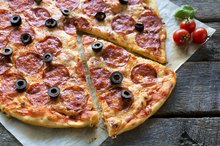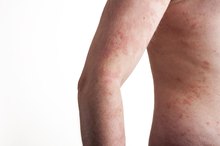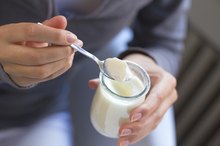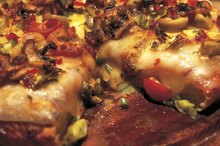What does fact checked mean?
At Healthfully, we strive to deliver objective content that is accurate and up-to-date. Our team periodically reviews articles in order to ensure content quality. The sources cited below consist of evidence from peer-reviewed journals, prominent medical organizations, academic associations, and government data.
- National Digestive Diseases Information Clearinghouse: Lactose Intolerance Facts and Treatment
- Office of Dietary Supplements: Calcium Fact Sheet
The information contained on this site is for informational purposes only, and should not be used as a substitute for the advice of a professional health care provider. Please check with the appropriate physician regarding health questions and concerns. Although we strive to deliver accurate and up-to-date information, no guarantee to that effect is made.
Foods to Eat If You Have Dairy Sensitivity & Yeast Overgrowth
Sensitivity to dairy products, also known as lactose intolerance, means you have difficulty digesting products derived from cow's milk. The condition is common, according to the National Digestive Diseases Information Clearinghouse, and most likely to occur in adulthood. Proponents of candida diets, or diets aimed at reducing yeast overgrowth, believe that dairy products trigger yeast production. In addition to limiting or avoiding dairy products, certain foods may help reduce yeast overgrowth and help prevent infections.
Fish and Seafood
Fish and seafood provide rich amounts of protein and nutrients, such as B-vitamins, iron, vitamin D and calcium. Candida overgrowth and infections are linked with low-calcium intake, according to the University of Maryland Medical Center 1. Since dairy products are major contributors of calcium in Americans' diets, seeking alternate sources of calcium, such as fish and seafood, may help reduce your risk for yeast overgrowth and improve your overall health. Three ounces of sardines provide roughly 1/3 of the daily recommended allowance of calcium -- more calcium than eight ounces of milk provides. Additional calcium-rich fish and seafood varieties include:
- salmon
- crab
- lobster
- anchovies
- shrimp
- bass
- catfish
- haddock
- tuna
- halibut
To maximize your calcium intake, opt for canned tuna or salmon, which contain calcium-containing bone particles. Fatty fish, such as
- salmon
- albacore tuna
- herring
- halibut
- also provide omega-3 fatty acids -- healthy fats that may help alleviate inflammation associated with yeast infections
- Fish and seafood provide rich amounts of protein and nutrients, such as B-vitamins, iron, vitamin D and calcium.
- Since dairy products are major contributors of calcium in Americans' diets, seeking alternate sources of calcium, such as fish and seafood, may help reduce your risk for yeast overgrowth and improve your overall health.
Probiotics
Foods That Heal Infections
Learn More
Probiotics are healthy bacteria that enhance digestive health and help prevent bacterial infections. According to the University of Maryland Medical Center, probiotics may help prevent yeast infections if you consume them while taking antibiotics -- a common trigger of yeast overgrowth and infections 1. Probiotics may also ease digestion of dairy products. For this reason, dairy products containing probiotics, such as yogurt with live active cultures, may provide yeast-reducing benefits without exacerbating symptoms of your dairy sensitivity.
- Probiotics are healthy bacteria that enhance digestive health and help prevent bacterial infections.
- According to the University of Maryland Medical Center, probiotics may help prevent yeast infections if you consume them while taking antibiotics -- a common trigger of yeast overgrowth and infections 1.
Fruits and Vegetables
Fruits and vegetables provide valuable amounts of vitamins, minerals and antioxidants -- nutrients that help your body defend itself against infections and disease. Fruits and vegetables are also naturally free of dairy products, low in fat and high in fiber. The University of Maryland Medical Center recommends vitamin C-rich varieties, such as bell peppers, citrus fruits and tomatoes, in particular if you struggle with recurrent yeast infections 1. Other fruits and vegetables rich in antioxidants include:
- cantaloupe
- berries
- cherries
- apples
- red plums
- kiwi
- spinach
- kale
- broccoli
- carrots
- squash
- sweet potatoes
Turnip greens, kale, Chinese cabbage and broccoli also provide modest amounts of calcium.
- Fruits and vegetables provide valuable amounts of vitamins, minerals and antioxidants -- nutrients that help your body defend itself against infections and disease.
- Fruits and vegetables are also naturally free of dairy products, low in fat and high in fiber.
Related Articles
References
- University of Maryland Medical Center: Candidiasis Facts and Treatment
- Office of Dietary Supplements: Calcium Fact Sheet
- Planned Parenthood. What is a yeast infection?
- InformedHealth.org [Internet]. Cologne, Germany: Institute for Quality and Efficiency in Health Care (IQWiG); 2006-. Vaginal yeast infection (thrush): Overview. 2019 Jun 19.Available from: https://www.ncbi.nlm.nih.gov/books/NBK543220/
- Singh A, Verma R, Murari A, Agrawal A. Oral candidiasis: An overview. J Oral Maxillofac Pathol. 2014;18(Suppl 1):S81–S85. doi:10.4103/0973-029X.141325
- Jeanmonod R, Jeanmonod D. Vaginal Candidiasis (Vulvovaginal Candidiasis) [Updated 2020 Feb 4]. In: StatPearls [Internet]. Treasure Island (FL): StatPearls Publishing; 2020 Jan-. Available from: https://www.ncbi.nlm.nih.gov/books/NBK459317/
- InformedHealth.org [Internet]. Cologne, Germany: Institute for Quality and Efficiency in Health Care (IQWiG); 2006-. Oral thrush: Overview. 2012 Apr 26 [Updated 2019 Aug 15].Available from: https://www.ncbi.nlm.nih.gov/books/NBK367586/
- Blostein F, Levin-sparenberg E, Wagner J, Foxman B. Recurrent vulvovaginal candidiasis. Ann Epidemiol. 2017;27(9):575-582.e3. doi:10.1016/j.annepidem.2017.08.010
- Aguin TJ, Sobel JD. Vulvovaginal candidiasis in pregnancy. Curr Infect Dis Rep. 2015;17(6):462. doi:10.1007/s11908-015-0462-0
- Rajalakshmi R, Kalaivani S. Prevalence of asymptomatic infections in sexually transmitted diseases attendees diagnosed with bacterial vaginosis, vaginal candidiasis, and trichomoniasis. Indian J Sex Transm Dis AIDS. 2016;37(2):139–142. doi:10.4103/0253-7184.192121
- Ringdahl EN. Treatment of recurrent vulvovaginal candidiasis. Am Fam Physician. 2000;61(11):3306-12, 3317.
- Aguin TJ, Sobel JD. Vulvovaginal candidiasis in pregnancy. Curr Infect Dis Rep. 2015 Jun;17(6):462. doi: 10.1007/s11908-015-0462-0.
- Blostein F, Levin-Sparenberg E, Wagner J, Foxman B. Recurrent vulvovaginal candidiasis. Ann Epidemiol. 2017 Sep;27(9):575-582.e3. doi: 10.1016/j.annepidem.2017.08.010.
- Chew SY, Than LT. Vulvovaginal candidosis: contemporary challenges and the future of prophylactic and therapeutic approaches. Mycoses. 2016 May;59(5):262-73. doi: 10.1111/myc.12455.
- Roberts CL, Algert CS, Rickard KL, Morris JM. Treatment of vaginal candidiasis for the prevention of preterm birth: a systematic review and meta-analysis. Syst Rev. 2015 Mar 21;4:31. doi: 10.1186/s13643-015-0018-2.
- Xie HY, Feng D, Wei DM, Mei L, Chen H, Wang X, Fang F. Probiotics for vulvovaginal candidiasis in non-pregnant women. Cochrane Database Syst Rev. 2017 Nov 23;11:CD010496. doi: 10.1002/14651858.CD010496.pub2.
Writer Bio
August McLaughlin is a certified nutritionist and health writer with more than nine years of professional experience. Her work has been featured in various magazines such as "Healthy Aging," "CitySmart," "IAmThatGirl" and "ULM." She holds specializations in eating disorders, healthy weight management and sports nutrition. She is currently completing her second cookbook and Weight Limit—a series of body image/nutrition-related PSAs.









